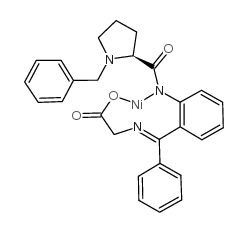96293-19-5
| Name | (s)-(o-(N-benzylprolyl)amino)(phenyl)methyleneiminoacetate |
|---|---|
| Synonyms |
(S)-2-{o-{(N-benzylprolyl)aMino}phenyl}-benzylideneaMino-acetato(2-)-N,N',N''-nickel(II)
NI-(S)-BPB-GLY Ni-(S)-BPB-GLy(S)-[O-[(N-Benzylprolyl)amino](phenyl)methyleneiminoacetate(2-)-N,N',N''-nickel(II) (S)-O-[(N-BENZYLPROLYL)AMINO](PHENYL)METHYLENEIMINOACETATE(2)-N,N',N''-NICKEL(II) (s)-(o-(N-benzylprolyl)amino)(phenyl) [N-[Phenyl[2-[[[1-(phenylmethyl)-2-pyrrolidinyl]carbonyl]amino]phenyl]methylene]glycinato(2-)-N,N',N'',O1]-nickel |
| Melting Point | 219-222ºC |
|---|---|
| Molecular Formula | C27H25N3NiO3 |
| Molecular Weight | 498.19900 |
| Exact Mass | 497.12500 |
| PSA | 62.21000 |
| LogP | 3.43190 |
| Index of Refraction | 1.62 |
| Storage condition | 2-8°C |
Synonym: Section 2 - COMPOSITION, INFORMATION ON INGREDIENTS
Risk Phrases: None Listed. Section 3 - HAZARDS IDENTIFICATION EMERGENCY OVERVIEW
The toxicological properties of this material have not been fully investigated. Potential Health Effects Eye: May cause eye irritation. Skin: May cause skin irritation. Ingestion: May cause irritation of the digestive tract. The toxicological properties of this substance have not been fully investigated. Inhalation: May cause respiratory tract irritation. The toxicological properties of this substance have not been fully investigated. Chronic: No information found. Section 4 - FIRST AID MEASURES Eyes: Immediately flush eyes with plenty of water for at least 15 minutes, occasionally lifting the upper and lower eyelids. Get medical aid. Skin: Get medical aid. Flush skin with plenty of water for at least 15 minutes while removing contaminated clothing and shoes. Wash clothing before reuse. Ingestion: Never give anything by mouth to an unconscious person. Get medical aid. Do NOT induce vomiting. If conscious and alert, rinse mouth and drink 2-4 cupfuls of milk or water. Inhalation: Remove from exposure and move to fresh air immediately. If not breathing, give artificial respiration. If breathing is difficult, give oxygen. Get medical aid. Notes to Physician: Section 5 - FIRE FIGHTING MEASURES General Information: As in any fire, wear a self-contained breathing apparatus in pressure-demand, MSHA/NIOSH (approved or equivalent), and full protective gear. During a fire, irritating and highly toxic gases may be generated by thermal decomposition or combustion. Extinguishing Media: Use water spray, dry chemical, carbon dioxide, or appropriate foam. Section 6 - ACCIDENTAL RELEASE MEASURES General Information: Use proper personal protective equipment as indicated in Section 8. Spills/Leaks: Sweep up, then place into a suitable container for disposal. Avoid generating dusty conditions. Provide ventilation. Section 7 - HANDLING and STORAGE Handling: Wash thoroughly after handling. Remove contaminated clothing and wash before reuse. Minimize dust generation and accumulation. Avoid contact with eyes, skin, and clothing. Avoid ingestion and inhalation. Storage: Store in a tightly closed container. Store in a cool, dry, well-ventilated area away from incompatible substances. Section 8 - EXPOSURE CONTROLS, PERSONAL PROTECTION Engineering Controls: Facilities storing or utilizing this material should be equipped with an eyewash facility and a safety shower. Use adequate ventilation to keep airborne concentrations low. Exposure Limits CAS# 96293-19-5: United States OSHA: 1 mg/m3 TWA (as Ni) (listed under Nickel sol compounds). Belgium - TWA: (listed as nickel soluble compounds): 0.1 mg/m3 VL (as Ni) Malaysia: (listed as nickel soluble compounds): 0.1 mg/m3 TWA (inhalable fraction, as Ni) Netherlands: (listed as nickel soluble compounds): 0.1 mg/m3 MAC Ni) Spain: (listed as nickel soluble compounds): 0.1 mg/m3 VLA-ED (as Personal Protective Equipment Eyes: Wear appropriate protective eyeglasses or chemical safety goggles as described by OSHA's eye and face protection regulations in 29 CFR 1910.133 or European Standard EN166. Skin: Wear appropriate protective gloves to prevent skin exposure. Clothing: Wear appropriate protective clothing to prevent skin exposure. Respirators: A respiratory protection program that meets OSHA's 29 CFR 1910.134 and ANSI Z88.2 requirements or European Standard EN 149 must be followed whenever workplace conditions warrant respirator use. Section 9 - PHYSICAL AND CHEMICAL PROPERTIES Physical State: Powder Color: bordeux Odor: None reported. pH: Not available. Vapor Pressure: Not available. Viscosity: Not available. Boiling Point: Not available. Freezing/Melting Point: 219.00 - 222.00 deg C Autoignition Temperature: > 250 deg C (> 482.00 deg F) Flash Point: Not applicable. Explosion Limits, lower: Not available. Explosion Limits, upper: Not available. Decomposition Temperature: >250 deg C Solubility in water: insoluble Specific Gravity/Density: Not available. Molecular Formula: C27H25N3NiO3 Molecular Weight: 498.20 Section 10 - STABILITY AND REACTIVITY Chemical Stability: Stable under normal temperatures and pressures. Conditions to Avoid: Incompatible materials, dust generation, strong oxidants. Incompatibilities with Other Materials: Oxidizing agents. Hazardous Decomposition Products: Irritating and toxic fumes and gases. Hazardous Polymerization: Has not been reported. Section 11 - TOXICOLOGICAL INFORMATION RTECS#: CAS# 96293-19-5 unlisted. LD50/LC50: Not available. Carcinogenicity: Ni-(S)-BPB-GLy - California: carcinogen, initial date 5/7/04 (listed as Nickel compound NTP: Known carcinogen (listed as Nickel compounds). IARC: Group 1 carcinogen (listed as Nickel compounds). Section 12 - ECOLOGICAL INFORMATION Section 13 - DISPOSAL CONSIDERATIONS Dispose of in a manner consistent with federal, state, and local regulations. Section 14 - TRANSPORT INFORMATION IATA Not regulated as a hazardous material. IMO Not regulated as a hazardous material. RID/ADR Not regulated as a hazardous material. Section 15 - REGULATORY INFORMATION European/International Regulations European Labeling in Accordance with EC Directives Hazard Symbols: Not available. Risk Phrases: Safety Phrases: S 24/25 Avoid contact with skin and eyes. WGK (Water Danger/Protection) CAS# 96293-19-5: No information available. Canada None of the chemicals in this product are listed on the DSL/NDSL list. CAS# 96293-19-5 is not listed on Canada's Ingredient Disclosure List. US FEDERAL TSCA CAS# 96293-19-5 is not listed on the TSCA inventory. It is for research and development use only. SECTION 16 - ADDITIONAL INFORMATION N/A |
